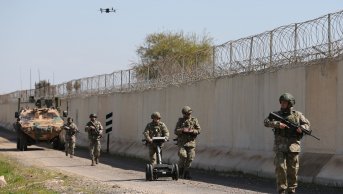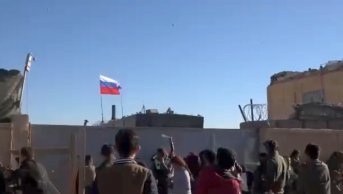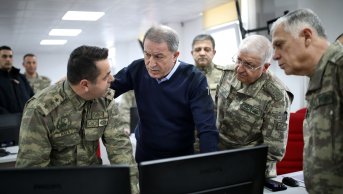Syrian Turkmen in Grip of Assad Regime, ISIS and PYD

The polarization between the al-Qaeda-linked Islamic State of Iraq and al-Sham (ISIS) fighting against the regime in Syria and all other armed opposition groups is deepening.
In fact, although there is no conflict between ISIS and another al-Qaeda-linked group, al-Nusra Front, the dispute is deepening between the two. Also, the Syrian opposition groups have clearly distinguished ISIS from al-Nusra Front. While al-Nusra has a positive image and has been at the forefront of the fight against Syrian President Bashar al-Assad’s regime along with the Free Syrian Army, ISIS is seen as a group that does not fight against the regime and that is trying to seize areas liberated by the opposition forces. The opposition is convinced that ISIS is affiliated with the Syrian regime and Iran. The presence of ISIS in northern Syria increasingly worries the opposition. ISIS has been arresting and killing the fighters of other armed groups. Since they have a central authority, they have an advantage over the dispersed opposition.
Another development in northern Syria is the fact that the Kurdish People’s Defense Units (YPG), which is the armed militia of the Democratic Union Party (PYD) of the Syrian Kurds, is advancing throughout the area. First, the YPG seized control of tripartite Kurdish regions (Jazirah, Kobani and Afrin). Currently, it is trying to connect the three separate Kurdish regions to one another and spread the conflict into areas populated by Arabs and Turkmen.
The Syrian Turkmen took sides with the opposition along with the Free Syrian Army from the beginning of the uprising. However, the Free Syrian Army is in an extremely weak position in the present multilateral conflicts in Syria. The regime is increasingly growing stronger and, at the same time, al-Qaeda-linked groups or Islamic groups are growing stronger among the armed opposition. Another group with growing influence in Turkmen-populated northern Syria is the Kurdish YPG. Currently, the Turkmen are doing the math on how they can survive in the face of pressure from these three groups.
They are almost all across the country, but the populations of Syrian Turkmen are dense in the rural areas of Aleppo and Latakia near the Turkish border crossing. Although they are not many in number, they live in areas that have strategic importance for Turkey. Two regions of Aleppo and Latakia near the Turkish border gate are also of great importance for the Assad regime, the PYD/YPG and ISIS.
The Turkmen-populated region in northern Latakia is known as Bayir-Bucak. The region is greatly significant for Assad’s regime to establish a geographic connection with the Hatay province in Turkey, which is on the border with Syria. Damascus, which has never accepted the annexation of Hatay by Turkey, considers Hatay its own territory and Syria has tried to bring the Hatay issue -- which had been put aside when the sides were in good relations -- to the agenda once again. The Syrian state news agency has recently published maps on its website showing Hatay within the borders of Syria. The Syrian regime attaches great importance to keeping its claim over Hatay alive so that its hand doesn’t weaken in regards to the Hatay issue.
The Free Syrian Army troops composed of Turkmen and Arabs in the region have seized control of some 30-kilometers of land between the Latakia province and Hatay. Nevertheless, the regime continues to attack the region by land and air, and thus it is not a safe zone. Therefore, the residential areas have been evacuated to a large extent and the people have migrated to Turkey. Recently, a bigger threat than the regime has appeared for the Bayır-Bucak Turkmen. ISIS has recently been infiltrating the region under the authority of the opposition, and it has been oppressing civilians and Turkmen military groups.
The same situation also applies to the Turkmen population living in northern Aleppo near the Turkish border crossing. Turkmen in this area are densely populated in the area located between Azaz and Jerablus. Turkmen seized control of their own settlements. However, ISIS has recently increased pressure on Turkmen in the region. The commander of a Turkmen military troop was arrested by ISIS on the grounds that he opposed the system ISIS wanted to establish in Jerablus. In addition to this, ISIS threatened fighters of another Turkmen military group, forcing them to join its ranks. Some Turkmen civilians have been killed, particularly in Manbij. Turkmen are worried about the rising oppression of ISIS, although no large-scale violence against the Turkmen has taken place yet.
There are various threats against and fears of the Turkmen populations in Aleppo. The first is that the regime will seize control over the entire central part of Aleppo if it is successful in military operations around Aleppo. Besides, the regime might also seize control of Al-Bab, which serves as a gate from the Turkmen districts in rural areas to central Aleppo. Thus, the regime’s army could easily turn toward the region between Azaz and Jerablus. In that case, all the Turkmen in Aleppo who have not yet migrated from their villages and towns will have to migrate to Turkey, because the regime is trying to restore stability by evacuating the settlements in opposition areas.
The third threat for the Turkmen population in Aleppo is that their settlement is among the targets of the Kurdish YPG militia. If the YPG seized control of Tel Abyad, establishing a connection between the eastern (Jazirah) and central (Kobani) parts of the tripartite Kurdish region, its next target would be to seize control of the Azaz-Jerablus region to establish a connection between central and western (Afrin) parts. If the goals stated by YPG spokesman Redur Khalil are achieved, it would come to mean that Turkmen military groups and the YPG will fight against one another.
In the face of all these developments, it should be stated that Turkmen military groups are in no shape to fight against any group. The Turkmen have tried to remain neutral in their region due to their weak position. Furthermore, the Turkmen military groups are worried about the fact that they have fought alongside the Free Syrian Army against al-Akrad, a military group subordinate to the YPG in Jerablus, Azaz and Manbij. The PYD’s militia force, the YPG, is showing a tendency of moving toward the Turkmen settlements and the Turkmen groups are not strong enough to resist the YPG if the YPG advances against their settlements.
In that case, the Turkmen in Aleppo may prefer to reach a diplomatic agreement with the PYD/YPG rather than fight against them. Recently, the PYD/YPG has been making efforts to establish closer ties in order to act together with the Free Syrian Army and Turkmen.










